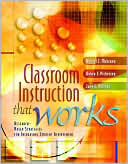Brain-Based Teaching in the Digital Age
Smartphones, videogames, webcasts, wikis, blogs, texting, emoticons. What does the rapidly changing digital landscape mean for classroom teaching? How has technology affected the brain development of students? How does it relate to what we know about learning styles, memory, and multiple intelligences? How can teachers close the digital divide that separates many of them from their students?\ In Brain-Based Teaching in the Digital Age, Marilee Sprenger answers these and other questions with...
Search in google:
Smartphones, videogames, webcasts, wikis, blogs, texting, emoticons. What does the rapidly changing digital landscape mean for classroom teaching? How has technology affected the brain development of students? How does it relate to what we know about learning styles, memory, and multiple intelligences? How can teachers close the digital divide that separates many of them from their students?In Brain-Based Teaching in the Digital Age, Marilee Sprenger answers these and other questions with research-based information and practical advice gained from her years as a classroom teacher and a consultant on brain-based teaching. As she puts it, "it's time to meet the 'digital brain.' We need to use the technology tools, learn the digital dialogue, and understand and relate better to our students." At the same time, she emphasizes the importance of educating the whole child by including exercise, music, and art in the classroom and helping students develop their social-emotional intelligence. Creativity, empathy, and the ability to synthesize material are 21st century skills that can't be ignored in the digital age.Readers will find easy-to-understand information about the digital brain and how it works, "high-tech" and "low-tech" strategies for everyday teaching and learning, and inspiration for creating classroom environments that will entice and encourage students at all grade levels. With this book as a guide, educators can move confidently across the digital divide to a world of new possibilities-for themselves and their students.
Acknowledgments ixIntroduction xiPart 1 Digital Technology and the Brain 11 iPod + iPhone + iVideo + Internet = iBrain 32 Recent Research on the Brain: We Need Low Tech, Too 173 Do Brain-Based Principles Apply in the Digital Age? 26Part 2 Desk Space, MySpace, My Style 414 Environments for Learning 435 Social Networking Through Teams 576 Understanding Learning Styles 707 The Digital Native and Intelligence 81Part 3 Music, Mind Maps, and Memory 898 The Digital Brain and Music 919 Visual Tools 10110 Flash Blubs and Flash Drives: Understanding How Memory Works 110Part 4 Balancing Digital Desires with Digital Natives' Needs 12711 The Balancing Act 12912 The Present and the Future of Learning 141Appendix A How the Brain Works 151Appendix B How Tech Savvy Are You? 161Appendix C Glossary of Digital Terms 163References 165Index 171About the Author 177








